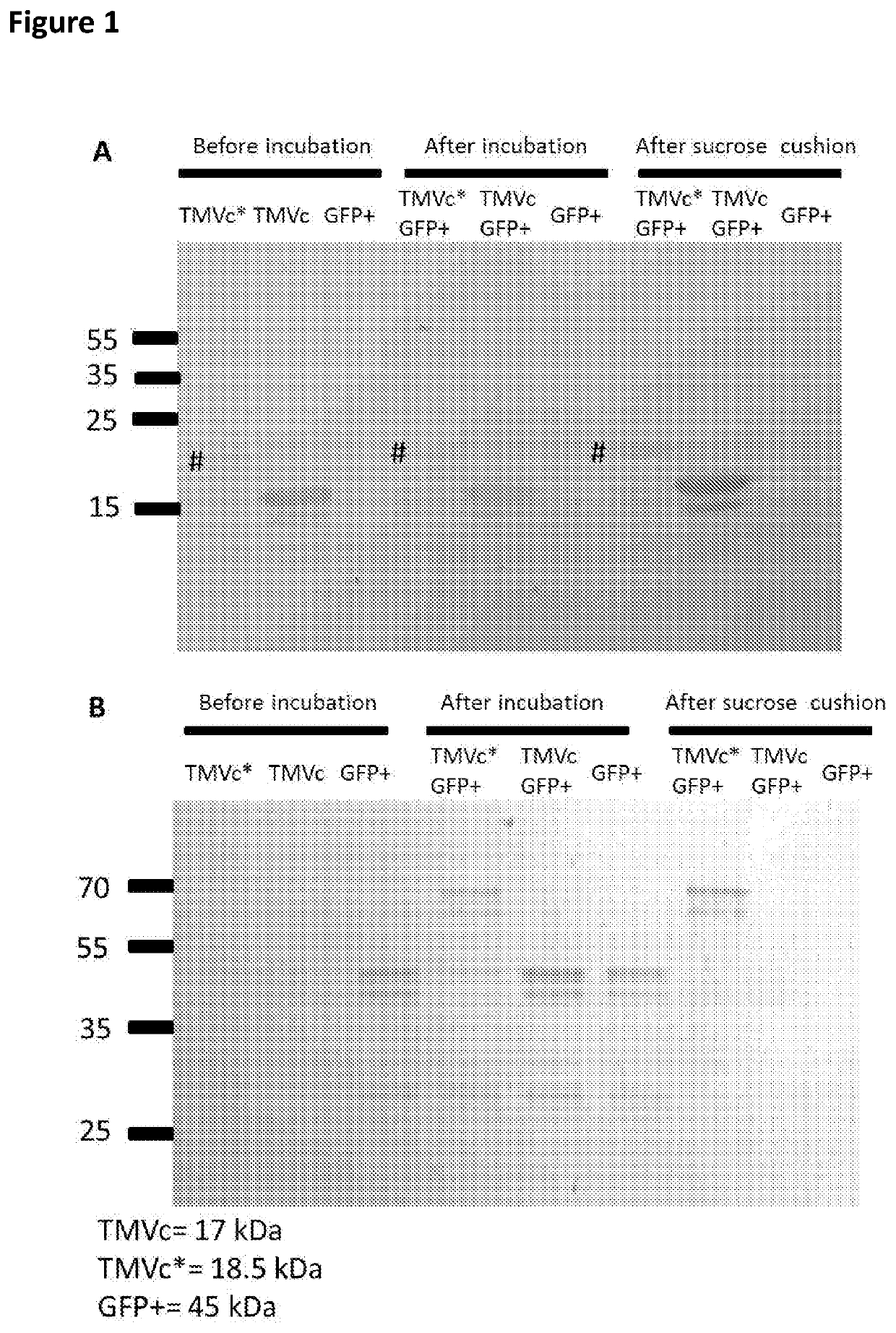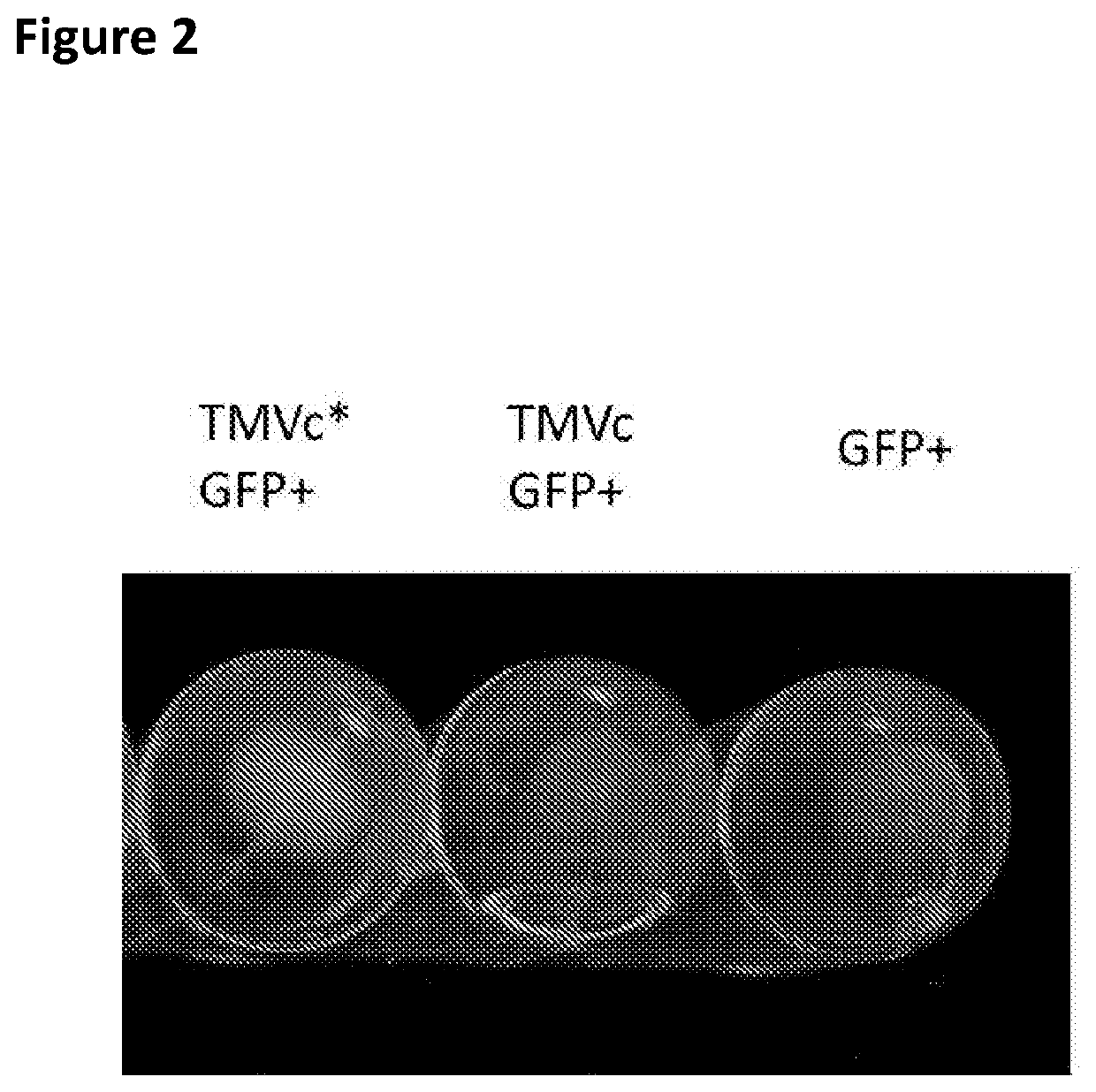Nanonets and spherical particles
a macroscale nanomaterial and nanotechnology, applied in the field of macroscale macromolecule complexes comprising microns, can solve the problems of reducing peptide/protein reactivity and limited surface display systems, and achieve the effect of rapid surface presentation and effective production of bioactive 2d/3d macromolecule nanomaterials
- Summary
- Abstract
- Description
- Claims
- Application Information
AI Technical Summary
Benefits of technology
Problems solved by technology
Method used
Image
Examples
example 1
and Plasmids
[0090]For the SpyTag-TMV (TMVc*), the TMV E50Q and D77N group modified coat protein sequence (TMVc; Brown et al., 2013) was fused at its C-terminal end to the SpyTag sequence (Long et al., 2013). For the SpyCatcher-GFP sequence (GFP+), SpyCatcher (Long et al., 2013) was fused to the N-terminal end of the eGFP sequence (GenBank: AAG27429.1). For the GalEst, this consisted of a UDP-glucose 4-epimerase sequence (GenBank: EIE36183.1) to which a 6 His and SpyTag sequence was attached at its N-terminal end. For the TMV CP-GGGGS SpyCatcher His, the TMVc* sequence had a 3x GGGGS linker-6 His-SpyCatcher fused to its C-terminal end. For the TMV CP-GGGGS-SpyTag His, a 3x GGGGS linker-SpyTag-6 His, was fused to the C-terminal end of the TMVc*. For the 11-20 SpyCatcher (SEQ ID NO: 13), a small Psoroptes ovis peptidic sequence was fused to the C-terminal of the SpyCatcher. These were codon optimized for bacterial expression and cloned into a pET-21a(+) vector by Genscript (Piscataway,...
example 2
n in Bacteria and Isolation of Proteins or Virus Structures
[0091]Bacteria containing the plasmids were grown at 37° C. with shaking at 200 rpm in LB media supplemented with 100 μg / ml ampicillin and 34 μg / ml chloramphenicol. Once cultures reached an OD 600 of 0.5, IPTG was added to a final concentration of 0.1 mM, and induction proceeded overnight at 20° C. with shaking at 200 rpm. Bacteria were pelleted by centrifugation at 4000 g for 15 minutes, the supernatant was removed and the cells were lysed by freeze-thawing 3 times using liquid nitrogen and a 37° C. water bath, before proceeding with protein extraction using the B-PER Complete reagent (ThermoFisher Scientific, Paisley, UK). Lysates obtained with the B-PER Complete reagent were centrifuged at 10,000 g for 20 minutes to remove debris. The lysates were combined (TMVc* or TMVc were mixed with GFP+) in equal volume and incubated at room temperature for 1 hour prior to centrifugation on a 20% sucrose cushion, after which the pell...
example 3
TMVc Purification and Buffer Exchange of GFP+ Prior to Transmission Electron Microscopy
[0094]To the centrifuged TMV structure lysates, PEG 8000 and NaCl were added to a final concentration of 2% and 1% respectively, and the solutions were incubated at 4° C. overnight to ensure precipitation. These were centrifuged at 10000 g at 4° C. for 20 minutes to pellet the virus structures. The pellets were resuspended in 25 mM tris-HCl (pH 7.8), centrifuged at 10000 g to clarify and the supernatants were collected. Another two rounds of resuspension and centrifugation was carried out to obtain maximal virus structure yields, while minimizing debris. The clarified supernatants were then loaded onto 2 ml 20% sucrose 25 mM Tris-HCl (pH 7.8) cushions, which was then centrifuged in swing out rotors (SW41 Beckman Coulter; Beckman Coulter, California, USA) at 32000 rpm for 2 hours at 4° C. Pellets were resuspended in 0.01 M Tris-HCl (pH 7.8), ultracentrifuged at 32000 rpm for 2 hours at 4° C. in a S...
PUM
| Property | Measurement | Unit |
|---|---|---|
| size | aaaaa | aaaaa |
| temperatures | aaaaa | aaaaa |
| length scales | aaaaa | aaaaa |
Abstract
Description
Claims
Application Information
 Login to View More
Login to View More - R&D
- Intellectual Property
- Life Sciences
- Materials
- Tech Scout
- Unparalleled Data Quality
- Higher Quality Content
- 60% Fewer Hallucinations
Browse by: Latest US Patents, China's latest patents, Technical Efficacy Thesaurus, Application Domain, Technology Topic, Popular Technical Reports.
© 2025 PatSnap. All rights reserved.Legal|Privacy policy|Modern Slavery Act Transparency Statement|Sitemap|About US| Contact US: help@patsnap.com



